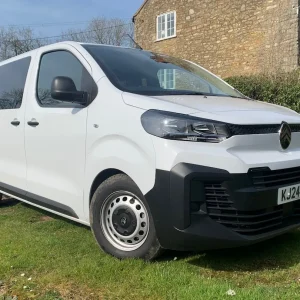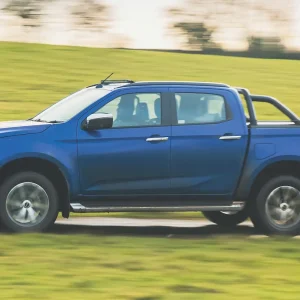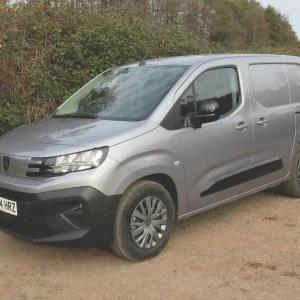Unlike most panel vans that have been sourced from South East Asian manufacturers over the years, iLoad has been designed with the needs of European buyers firmly in mind. Hyundai has eschewed a forward-control set-up where the driver sits above the engine in favour of a semi-forward control layout, where the driver sits behind it. That makes entering and exiting the cab a lot easier and provides the occupants with a pleasanter working environment.
Technical
 With one wheelbase, one roof height and two trim levels — Classic and the more upmarket Comfort — iLoad is powered by a 2.5-litre CRDi four-cylinder 16-valve common rail diesel. Maximum power of 114hp kicks in at 3,800rpm, while a healthy 343Nm — quite a lot of torque for a vehicle of this size — bites across a 1,750rpm-to-2,500rpm plateau.
With one wheelbase, one roof height and two trim levels — Classic and the more upmarket Comfort — iLoad is powered by a 2.5-litre CRDi four-cylinder 16-valve common rail diesel. Maximum power of 114hp kicks in at 3,800rpm, while a healthy 343Nm — quite a lot of torque for a vehicle of this size — bites across a 1,750rpm-to-2,500rpm plateau.
The engine is married to a five-speed manual gearbox and it’s interesting to note that the new Hyundai is rear-wheel drive. That’s unusual given that most products in this sector have the drive taken to the front wheels.
Independent suspension with MacPherson struts is installed at the front while leaf springs help support the back of the van. Steel 16in wheels shod with 215/70 R16C tyres — Hankook RA08s on the iLoad we tested — come as standard.
Ventilated disc brakes are fitted all round — 300mm diameter at the front, 324mm at the back — and ABS and Electronic Brakeforce Distribution both form part of the package. Our demonstrator was also equipped with Electronic Stability Programme (ESP) for an extra £450; all prices quoted here exclude VAT. In our view it should be fitted as standard on the majority of light commercials. Hydraulically-assisted, the rack-and-pinion steering offers 3.6 turns lock-to lock.
Grossing at 3,160kg, Hyundai’s new baby can cope with a payload of up to 1,062kg and can tow a braked trailer grossing at up to 2,300kg. Make full use of its payload and towing capacity and you’ll be in tachograph and Drivers’ Hours territory. Hyundai says that iLoad is capable of being fitted with a digital tachograph but it’s not clear whereabouts it could be mounted in the cab.
Load Area
 A sliding door on each side of the body plus twin side-hinged rear doors provide access to the 4.3m3 cargo box. Equipped with heavily-tinted and heated windows, but no wash-wipe system, the back doors can be swung through 90° and through 180° if you pull out the pins that keep the stays in place. The pins are on thin rubber straps that are almost guaranteed to chafe or snap. It’s a somewhat fiddly set-up and you’re sure to get grease on your fingers. Putting the pins back is a fiddly task too.
A sliding door on each side of the body plus twin side-hinged rear doors provide access to the 4.3m3 cargo box. Equipped with heavily-tinted and heated windows, but no wash-wipe system, the back doors can be swung through 90° and through 180° if you pull out the pins that keep the stays in place. The pins are on thin rubber straps that are almost guaranteed to chafe or snap. It’s a somewhat fiddly set-up and you’re sure to get grease on your fingers. Putting the pins back is a fiddly task too.
Maximum load length is 2,375mm. Maximum width is 1,620mm narrowing to 1,260mm between the wheel boxes, while maximum height is 1,350mm. Rear loading height is 635mm and the rear door aperture is 1,270mm high and 1,346mm wide. Dimensions for the side door apertures are 1,346mm and 863mm respectively.
Good to see that no less than 10 load tie-down points are provided and that a full height, glazed, steel bulkhead comes as standard, even though it bulges into the cargo area, stealing space. Not quite so good is the level of defence against minor scratches and scrapes. While the sides and doors are clad with protective panelling to half their height, no protection is provided for either the wheel boxes or the cargo bed.
Cab Comfort
 In a bid to re-establish itself in the van market Hyundai is majoring on iLoad’s high standard of equipment. Opt, as we did, for Comfort specification and air conditioning comes as standard. So do electric windows and mirrors — the latter would benefit from a wide-angle section — driver and passenger airbags and a good-quality MP3-compatible stereo radio/CD player with a decent set of speakers. That makes a pleasant change when compared with the low-grade buzz-boxes fitted in all too many van cabs.
In a bid to re-establish itself in the van market Hyundai is majoring on iLoad’s high standard of equipment. Opt, as we did, for Comfort specification and air conditioning comes as standard. So do electric windows and mirrors — the latter would benefit from a wide-angle section — driver and passenger airbags and a good-quality MP3-compatible stereo radio/CD player with a decent set of speakers. That makes a pleasant change when compared with the low-grade buzz-boxes fitted in all too many van cabs.
For your money you get three seats, but the middle one is of limited practical use. It’s narrow, the hapless occupant has insufficient leg room and is held in place solely by a lap-strap. Nor is the seat fitted with a headrest, unlike its two companions.
Squash somebody onto this perch and you’ve just made the pop-out twin cup holder mounted in the dashboard unusable because it will catch their knees. Frankly we don’t think this seat is suitable for even a brief local trip. Its only saving grace is the way in which the back flips down and turns into a handy tray complete with two cup holders.
Both the driver’s seat and the steering column are height-adjustable and there’s a reasonable, but by no means vast, amount of stowage space for all the paraphernalia that van drivers cart around with them. Each door features both an upper and a lower bin; the latter includes a moulding that will hold a bottle of water or a flask. Two gloveboxes are provided, neither of which are enormous, and there’s a tray on top of the facia.
The gearstick sits on a moulding that bulges out from the front of the nicely laid out, attractive-looking dashboard while the driver’s door plays host to a button that releases the fuel flap. It also accommodates a button that you hit to lock or unlock all the doors.
Chunky heating, ventilation and air con controls make life easier as do the MP3-compatible radio/CD player’s big, clearly marked, switches. The dashboard harbours an auxiliary power point too.
On the Road
 If you’re on city centre delivery work or dropping off packages on a rural route, then iLoad’s got more than enough power on tap to meet your needs. Thanks to all that torque the free-revving engine digs in determinedly whenever you encounter a hill and should allow you to more than hold your own in traffic.
If you’re on city centre delivery work or dropping off packages on a rural route, then iLoad’s got more than enough power on tap to meet your needs. Thanks to all that torque the free-revving engine digs in determinedly whenever you encounter a hill and should allow you to more than hold your own in traffic.
If you’re zipping up and down the motorway from one big city to the next, however, then you’ll be looking to harness a few more horses. In this context it’s interesting to note that Hyundai is contemplating slotting the 168hp version of the 2.5-litre CRDi diesel already installed in the i800 into iLoad.
That’s probably over-egging the pudding – a 130hp variant of the same engine as an alternative to the 115hp lump would, however, be perfectly acceptable if married to a six-speed ’box.
All the power in the world is of little consequence if you have to wrestle with a lousy gearchange, but thankfully iLoad’s is pretty much glitch-free. The Hyundai handles well too, with ample feedback through the steering thanks to the use of hydraulic rather than electric assistance, and noise is well-suppressed.
On the downside the unladen ride is nervous, with the suspension struggling to cope with uneven surfaces. Load a few bags of gravel into the cargo bay and things calm down.
Struggling with grim winter weather, we greatly welcomed the triple screenwash jets that service each wiper blade. Six jets soon blast the dirt off your windscreen and it’s a pity that so few vans offer this facility.
As far as fuel consumption is concerned we averaged 32mpg during the test period.
While iLoad is a good-looking, well-put-together van, certain aspects of its exterior design will frustrate signwriters. All those indentations in the side panels will make it difficult for them to apply adhesive vinyl livery.
The vehicle’s sides also suffer from one major omission; no side rubbing strips to protect them from minor scratches and scrapes and no protection for the wheelarches either. That’s a pity given that our test van was finished in metallic paint for an extra £340.
A far more significant omission is the lack of remote central locking. All you get is a plain old-fashioned key for the doors and the ignition, with no plip buttons. It’s a serious drawback from both the convenience and security viewpoint, and one that Hyundai must rectify as a matter of urgency.
We understand that a remote system is to be offered as an option in a package that includes an alarm, but that’s not good enough. It should be fitted as standard and it should be fitted now.
Flip open the bonnet and you’ll gain easy access to the screenwash reservoir, dipstick and oil filler point. Service intervals are set at 10,000 miles and Hyundai should really think about extending them. All models are protected by a generous five year/100,000 mile warranty plus RAC breakdown cover, including recovery and home assistance, for the first year of ownership.
Verdict
Remarkably well-equipped if ordered in Comfort trim, Hyundai’s attractively-priced iLoad is a welcome new entrant to the UK panel van market. It looks good, handles well, offers a user-friendly gearchange and its easily-accessible cargo area boasts ten load tie-down points plus a full-height steel bulkhead. With a surprising amount of torque on tap, the engine should easily meet the needs of local trades people or couriers on around-the-town delivery work. The unladen ride is choppy, there’s insufficient room for the three-man cab’s centre passenger and the absence of remote central locking is a surprising omission. It’s one that needs rectifying. On balance, however, there’s a lot more to like than dislike about iLoad. Go check it out.

 You’ve got to feel sorry for Hyundai. After several years without a presence in the UK light commercial market, the Korean manufacturer is returning to it in the teeth of what’s shaping up to be the worst recession since World War Two. It’s making its comeback with iLoad. Derived from the eight-seater i800 people-carrier, it’s an attractively-priced new rival to vans such as Peugeot’s Expert, Volkswagen’s Transporter and Renault’s Trafic.
You’ve got to feel sorry for Hyundai. After several years without a presence in the UK light commercial market, the Korean manufacturer is returning to it in the teeth of what’s shaping up to be the worst recession since World War Two. It’s making its comeback with iLoad. Derived from the eight-seater i800 people-carrier, it’s an attractively-priced new rival to vans such as Peugeot’s Expert, Volkswagen’s Transporter and Renault’s Trafic. 



